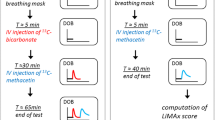Summary
The exhalation of 14CO2 derived from an i.v. tracer dose of [dimethylamine-14C]aminopyrine has been investigated in normal controls and patients. They subsequently ingested 200 mg cyclobarbital calcium in the evening and the decline in the plasma drug level over the following 2 days was measured by thin-layer chromatography. The peak specific activity of exhaled 14CO2 occurred 0.5–2 h after 14C-aminopyrine injection in the absence of liver disease and in non-cirrhotic liver disorders. It was delayed in certain patients with cirrhosis. Compared to 8 medically healthy subjects, 10 patients with acute viral hepatitis, 8 with cirrhosis and 10 with fatty liver exhibited a significantly increased half-life of 14CO2 exhalation. Normal mean values were found in 12 patients with non-cirrhotic alcoholic liver disease and in 14 patients with non-hepatic diseases. The cyclobarbital (CB) half-life was prolonged and the clearance reduced in patients with viral hepatitis, cirrhosis, or alcoholic liver damage as compared to data from 17 control subjects. Due to a larger apparent volume of distribution, patients with fatty liver disease had an increased CB half-life, although its clearance was normal. A close negative correlation was detected between the clearance and the logarithm of the CB level measured 36 h after drug ingestion. The oral CB test evaluated from a single blood sample taken about 36 h after drug administration appears to be a useful indicator of human drug metabolising capacity. Discrimination between patients with and without disordered liver function was similar in the two drug elimination tests.
Similar content being viewed by others
References
Branch RA (1982) Drugs as indicators of hepatic function. Hepatology 2: 97–105
Hepner GW, Vesell ES (1975) Quantitative assessment of hepatic function by breath analysis after oral administration of [14C]-aminopyrine. Ann Int Med 83: 632–638
Saunders JB, Lewis KO, Paton A (1980) Early diagnosis of alcoholic cirrhosis by the aminopyrine breath test. Gastroenterology 79: 112–114
Hepner GW, Vesell ES (1974) Assessment of aminopyrine metabolism in man by breath analysis after oral administration of 14C-aminopyrine. Effects of phenobarbital, disulfiram and portal cirrhosis. N Engl J Med 291: 1384–1388
Bircher J, Kuepfer A, Gikalov I, Preisig R (1976) Aminopyrine demethylation measured by breath analysis in cirrhosis. Clin Pharmacol Ther 20: 484–492
Noordhoek J, Dees J, Savanije-Chapel EM, Wilson JHP (1978) Output of 14CO2 in breath after oral administration of (14C-methyl)aminopyrine in hepatitis, cirrhosis and hepatic bilharziasis: its relationship to aminopyrine pharmacokinetics. Eur J Clin Pharmacol 13: 223–229
Henry DA, Sharpe G, Chaplain S, Cartwright S, Kitchingman G, Bell GD, Langman MJS (1979) The [14C]-aminopyrine breath-test. A comparison of different forms of analysis. Br J Clin Pharmacol 8: 539–545
Pauwels S, Geubel AP, Dive C, Beckers C (1982) Breath 14CO2 after intravenous administration of [14C]aminopyrine in liver diseases. Dig Dis Sci 27: 49–56
Breyer-Pfaff U, Harder M, Egberts EH (1982) Plasma levels of parent drug and metabolites in the intravenous aminopyrine breath test. Eur J Clin Pharmacol 21: 521–528
Alvin J, McHorse T, Hoyumpa A, Bush MT, Schenker S (1975) The effect of liver disease in man on the disposition of phenobarbital. J Pharmacol Exp Ther 192: 224–235
Inaba T, Tang BK, Endrenyi L, Kalow W (1976) Amobarbital — probe of hepatic drug oxidation in man. Clin Pharmacol Ther 20: 439–444
Zilly W, Breimer DD, Richter E (1978) Hexobarbital disposition in compensated cirrhosis of liver. Clin Pharmacol Ther 23: 525–534
Hoyumpa Jr AM, Schenker S (1982) Major drug interactions: effect of liver disease, alcohol, and malnutrition. Ann Rev Med 33: 113–149
Breyer-Pfaff U, Jerg H, Petruch F (1979) Cyclobarbital as a test substance for oxidative drug metabolism in man. Findings in neuropsychiatric patients. Eur J Clin Pharmacol 15: 433–441
Breyer-Pfaff U, Weber M, Seyfert H, Egberts EH (1983) Cyclobarbital and aminopyrine elimination as indices of hepatic drug metabolism in medical patients. Naunyn-Schmiedeberg's Arch Pharmacol 322 [Suppl]: R 127
Breyer U, Villumsen D (1975) Thin-layer chromatographic determination of barbiturates and phenytoin in serum and blood. J Chromatogr 115: 493–500
Sachs L (1968) Statistische Auswertungsmethoden. Springer, Berlin Heidelberg New York
Irving CS, Schoeller DA, Nakamura KI, Baker AL, Klein PD (1982) The aminopyrine breath-test as a measure of liver function. A quantitative description of its metabolic basis in normal subjects. J Lab Clin Med 100: 356–373
Cummings AJ, Martin BK, Park GS (1967) Kinetic considerations relating to the accrual and elimination of drug metabolites. Br J Pharmacol Chemother 29: 136–149
Winchell HS, Stahelin H, Kusubov N, Slanger B, Fish M, Pollycove M, Lawrence JH (1970) Kinetics of CO2-HCO −3 in normal adult males. J Nucl Med 11: 711–715
Schoeller DA, Baker AL, Monroe PS, Krager PS, Schneider JF (1982) Comparison of different methods of expressing results of the aminopyrine breath test. Hepatology 2: 455–462
Mawer GE, Miller NE, Turnberg LA (1972) Metabolism of amylobarbitone in patients with chronic liver disease. Br J Pharmacol 44: 549–560
Ossenberg FW, Denis P, Pointard L, Benhamou JP (1973) Pentobarbital pharmacokinetics in cirrhosis. Digestion 8: 448–449
Carulli N, Manenti F, Ponz de Leon M, Ferrari A, Salvioli G, Gallo M (1975) Alteration of drug metabolism during cholestasis in man. Eur J Clin Invest 5: 455–462
Breimer DD, Zilly W, Richter E (1975) Pharmacokinetics of hexobarbital in acute hepatitis and after apparent recovery. Clin Pharmacol Ther 18: 433–440
Fretwurst F, Halberkann J, Reiche F (1932) Phanodorm und seine Wiederausscheidung mit dem Harn. Muench Med Wochenschr 79: 1429–1432
Abernethy DR, Greenblatt DJ (1982) Pharmacokinetics of drugs in obesity. Clin Pharmacokinet 7: 108–124
Weber M (1982) Kinetic und Bindung von Cylcobarbital bei internistischen Patienten. Thesis Universität Tübingen, FRG
Døssing M, Poulsen HE, Andreasen PB, Tygstrup N (1982) A simple method for determination of antipyrine clearance. Clin Pharmacol Ther 32: 392–396
Author information
Authors and Affiliations
Rights and permissions
About this article
Cite this article
Breyer-Pfaff, U., Seyfert, H., Weber, M. et al. Assessment of drug metabolism in hepatic disease: Comparison of plasma kinetics of oral cyclobarbital and the intravenous aminopyrine breath test. Eur J Clin Pharmacol 26, 95–101 (1984). https://doi.org/10.1007/BF00546715
Received:
Revised:
Issue Date:
DOI: https://doi.org/10.1007/BF00546715




